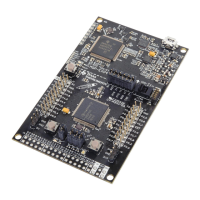Examining CCSv5
.cmd Linker command files tells the linker how to allocate memory and stitch your code and
libraries together. TI provides a default linker command file specific to each MSP430
device; it is automatically added to your project when you create a new project. You can
edit it, if needed, though most users get by without ever touching it.
.out The executable output file. This is the file that is loaded into Flash or FRAM on your
MSP430 MCU whenever you click the “Debug” button on your CCS toolbar.
.map The map file is a report created by the linker describing where all your code and data
sections were linked to in memory.
Please refer to the MSP430 Compiler User’s Guide (slau132.pdf
) and MSP430 Assembly
Language User’s Guide (slau131.pdf) for more information on the TI code generation tools.
The remaining “BUILD” tools shown in our diagram are related to the TI-RTOS kernel.
In essence, the TI-RTOS kernel is composed of many object code libraries. By creating a new
project based on the TI-RTOS template, CCS will automatically:
• Link in the required libraries
• Add the TI-RTOS configuration file (.cfg)
The configuration file provides a GUI interface for specifying which parts of the kernel you want to
use; helping you to create any static O/S objects that you want in your system; as well as creating
a second linker command file that tells the linker where to find all the kernel’s libraries.
While we briefly discuss TI-RTOS scheduling and threads during the Interrupts chapter of this
workshop, we recommend you take a look at the TI-RTOS Kernel Workshop
1
if you want more
information.
1
http://processors.wiki.ti.com/index.php/Introduction_to_the_TI-RTOS_Kernel_Workshop
MSP430 Workshop - Programming C with CCS 2 - 11

